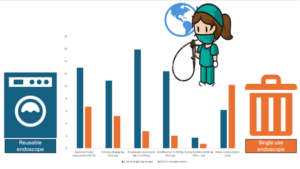Professor El-Omar has selected Dr Mathieu Pioche, Hospices Civils de Lyon, Lyon, France to do the next #GUTBlog. Dr Pioche is the first author on this paper.
The #GUTBlog focusses on the paper “Environmental impact of single-use versus reusable gastroscopes” which was published in paper copy in GUT in November 2024.

“Since the 1970s and the development of endoscopy, our endoscopes have been reusable, durable tools, requiring disinfection after each use to prevent the transmission of infectious agents from one patient to another[1,2].
This disinfection process has become one of the cornerstones of modern endoscopy, with a codified process, national or international standards, and specific machines competing with each other in terms of innovation to improve the efficiency of this decontamination and the storage of endoscopes after decontamination. Despite the proven quality of this cleaning, it is an impacting element of the workflow because it limits the immediate availability of an endoscope in the event of an emergency or when another specific tube is required during the procedure, it imposes a sequestration time after the procedure during which another endoscope must be used for the next patient and it requires staff to interrupt their clinical activity to clean the endoscope between two procedures.
These various constraints have fairly recently prompted manufacturers to develop single-use disposable endoscopes, offering high diagnostic performance and enabling a procedure to be carried out using sterile equipment, removed from its packaging immediately before the procedure and discarded immediately afterwards. While the organisational benefits are obvious, since there is no longer a decontamination phase between two procedures, the environmental[3] and economic impact of this strategy immediately raised questions in the endoscopy community in various disciplines (urology, anaesthesia, gastroenterology).
One of the first comparative evaluations carried out on disposable ureteroscopes showed, against all expectations, that the disinfection process had a discreetly greater impact than the disposable device itself[4], leading to an equivalence of the carbon impact of the two strategies when the endoscope is a very light device. On the contrary, this ratio was completely reversed, with the impact of disposable endoscopy more than 40 times greater when heavier, more complex endoscopes such as duodenoscopes were involved[5].
Before agreeing to any involvement in the evaluation of new disposable gastroscopes proposed by a manufacturer, we asked for help in carrying out a complete life cycle analysis comparing disposable and reusable endoscopes. This work was to be carried out with an independent company specialising in measuring the environmental impact of our care practices, in collaboration with the endoscopy unit at the Edouard Herriot Hospital in Lyon. Our objective was to obtain an exhaustive picture of the cumulative impact of the two strategies (disposable and reusable) by following the endoscope from its manufacture to its end of life. The various relevant environmental impacts were assessed (fossil resource depletion, water depletion, eutrophication and acidification) and not just the carbon footprint. The number of times reusable endoscopes were used and repaired was counted in order to calculate the environmental impact of each strategy for each procedure carried out.

Given the very high number of procedures carried out each year (several million per year in France), reusables are still the solution with the least impact on routine use, although their impact through disinfection is still significant. To protect our environment, we therefore need to assess each indication and reduce the number of procedures, reserving them for clinically relevant indications. Our manufacturers are also expected to make major efforts to reduce the impact of both strategies, with more economical washers for reusable products, for example, or bioplastics and recycling circuits for single-use products.
Lastly, while routine use seems to have less impact if reusables are favoured, certain specific situations need to be assessed. Endoscopes that are rarely used, such as specific therapeutic endoscopes (large channel) or certain formats specific to paediatrics or less frequent procedures (sleeve gastroplasty) could, on the contrary, have less impact in disposable form than in the under-used reusable version.
Similarly, small-volume, geographically isolated centres could use disposables to offer local endoscopies performed by a seconded practitioner, while reducing the overall environmental impact by cutting down on patient transport, since the difference in impact between disposables and reusables was equivalent to a car journey of less than 50 km.
References
1 Kwakman JA, Rauwers AW, Klaassen CHW, et al. Investigation of possible transmission of a susceptible microorganism through a contaminated duodenoscope; a case report. Antimicrob Resist Infect Control. 2021;10:127. doi: 10.1186/s13756-021-00996-7
2 Cristina ML, Sartini M, Schinca E, et al. Is Post-Reprocessing Microbiological Surveillance of Duodenoscopes Effective in Reducing the Potential Risk in Transmitting Pathogens? Int J Environ Res Public Health. 2019;17:E140. doi: 10.3390/ijerph17010140
4 Davis NF, McGrath S, Quinlan M, et al. Carbon Footprint in Flexible Ureteroscopy: A Comparative Study on the Environmental Impact of Reusable and Single-Use Ureteroscopes. J Endourol. 2018;32:214–7. doi: 10.1089/end.2018.0001
5 Le NNT, Hernandez LV, Vakil N, et al. Environmental and health outcomes of single-use versus reusable duodenoscopes. Gastrointest Endosc. 2022;96:1002–8. doi: 10.1016/j.gie.2022.06.014
Social Media